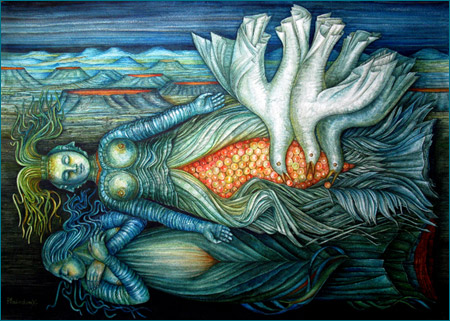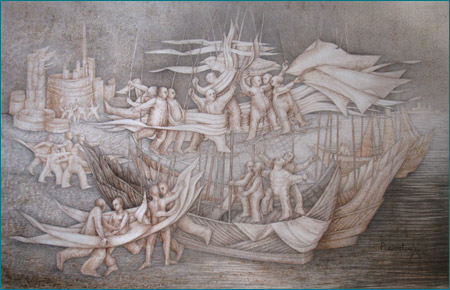 |
A large painting by Plaindoux, Les Vigiles, represents a stretch of stagnant water, divided by a perspective of intertwined beams. On a background of a starlit night, a group of characters flies over it. In these cells, human beings of every race and age are bathing, raising their heads to see it pass by. This troop seems to belong to an other species, an other people... The moon which stands out against the black sky does not have a halo. The tones are dark, olive green and brown. A patch of orange-colored light alone evokes, below the pontoons, a friendly, protected life. One could think that the beings from below are tortured beings. Not at all, they only wonder, like a flock of migrating birds about life on other shores, a different life... other possibilities...
Should we believe in a world in which superior powers would occupy the space between the supreme spirit and us? The painter suggests it, whilst implying that these entities may also only pass by, ignoring our destinies.
|
|
 |

Le Frai |
|
One can find in Plaindoux's works other creatures flocking together: swarms, hordes, a number of wings... Les voleurs de poules, Les Tisserands or Icare. In the Bâtisseurs who carry in the air the panels of a new town. In this troup consisting of women and birds that bring, in L'agneau Pascal, the sheep to sacrifice. In these Poissons migrateurs that glide in water seeking an elsewhere. There is often an aspiration to go, to ascend, to escape... like this group escaping, in a balloon, the narrow walls of an antique town or those who, imprisoned by branches, roots, clutched by the hand of a madwoman, attempt to free themselves in vain. The characters in the Renouées who seem to be flying freely are retained by their stem at the bottom of the water. In the Éclipse, the disabled person who is freeing himself from the protective arms of the angel can only stretch himself with his body towards the sky. The Captifs are the prisoners of pityless boughs, together with birds that are also tied. In the meantime, at the top of the tree, one of them flies away. Delivered at last!
All these winged beings, that rush into the air or into the water... are the counterparts of all those that are hampered by the braids, the ropes, the bandages, the solid feet that heavily rest on the ground, hampered by the folds, the heavy draperies which pull them towards the bottom.
Do not we need wings to free ourselves from what holds us, compels us, to escape that gravity which ties us to the earth and enprisons and enslaves our mind?
Others seem to chose, in a long progress, to seek a place where beaty and harmony are the rule. Theories, processions, start off... The point is always to celebrate, bring offerings, objects to be consecrated. Processionary reliefs, antique ceremonies, solemn processions in meditation...
Les Choéphores, Les sorciers, Les Lothophages... In spite of the ties that often hamper them, in spite of the masks that conceal their faces, they are marching towards a place where they will enjoy relief and bliss.
Does that heaven exist? All those who, in the Middle Age or in the Renaissance, represented the Paradise promised to its believers. Others only make it feel or contented themselves with the terrestrial beauty by adding some perfume of eternity. During her whole painter’s life, Plaindoux has also sought approaches of these enchantments. Even though the Eden she paints is a virtual one, is it not enough to make it exist on a few square centimetres to make this world, at least within that space, becomes real and allow the viewer’s soul to rest there? And Les Élus who fly away, bathed in a pink light, seem to be close to the target.
|
|

L'embarquement
|
 |
In her work, the decore remains a secondary plan. The trees, the rocks, the architectures sometimes have been fully redesigned before passing through the painter’s hand. This world is mainly a world of characters. They are timeless and immaterial. Their faces are often schematic, their eyes without pupils. Their hair borrows their volutes, their nerves from the vegetable kingdom. It is not meant to represent reality but allegories. They have no biography. They belong to a totally symbolic and graphic universe. Their life is limited to that place they occupy once and in a single location. They are not intended to mean an individual adventure but, by means of a shape, an attitude, a gesture... a thought or a feeling. They are the incarnation of an idea, the summary of a legend or the reflection of a myth. The titles of the paintings, most often beginning with a definite article, indicate indeed that it is in no way a specific story. There is a multitude of impressions condensed in a single picture. Everything must be said in that limited space.
|
|
If the meaning of these works sometimes seems to be unclear, it resides in the fact that it may be hidden to their author herself. Should she be too narrative, too explicite, should she lock herself into too obvious a representation, then she would keep her imagination and her viewers to go beyond what the pictures provide. It is necessary to come back to the painting; look at it again and again to find everytime maybe a content, new impressions and feelings. It is necessary to try and guess the artist’s intentions and see both what she brings and what she revives in you as archaic and deep reminiscences. The desires, the memories, the past experiences related to a gesture, a figure, an object... may be charged with emotion and cause a meaning to come up, a meaning that had been ignored so far.
One cannot be a painter in our epoch and ignore the many attempts to renew this art. At a crossroad, the artist is wondering: Which way should I take? Imitate those who have remained classic, because they did not want to disown the masters? Get my inspiration from the impressionnists’ colored sparkles? Or to set off on the iconoclastic undertakings of the Cubists, the Fauvists or the surrealists? Follow the fashions? Attempt, one more time, to offer something new, something surprising? Among all these streams, which one to chose to find oneself? It is impossible not to take into account what we have seen, understand and felt. If all this does not provide a solution to your own quest, isn’t it necessary, without ignoring what has been done before, to take on another way? The advantage of all these experimentations is that, if they may bewilder and confuse you, they have also opened the door to all possibities.
Plaindoux keeps on wondering: who are we? In what world have we been put? What is expected from us? What role do we have in the Universe and what is the artist’s position? The stars, the moon and the sun are often represented in the paintings as being as many questions. Does the astronomers’ and physicists’ answer correspond to that of the cosmogonies and legends? In Le 21 Mars, fertilized eggs revolve around planets in a cosmic panspermia. Lovers sow deep waters in Le Nautile and La Perle with their seeds.The meteor showers in the Perséïdes predict the future and angel Uriel overflies the Earth which is the prey of the fire of the Apocalypse. But Plaindoux also wonders how a plan grows, how life borrows multitudes of appearances and in what way we are united with all that lives. Each creature has perfected its own form in the course of milleniums and we are senitive to the seductions which surround us. The flowers exert their attractions over insects in order to be fertilized by them, but we too are moved by their vividness and their scent. We admire the colored plumage of birds, the grace and suppleness of felines. The beauty of natural things does not seem to be without cost. It allows them to communicate and interact with this huge creation, full of enigmas. As if all the beings had elaborated their own genesis themselves. If they have spread, over the course of evolution, their seeds and caused mutations and crossing to perfect, by trial and error, an anticipated goal. The artist should also make a modest contribution to the laws of universal invention. The onus is on the artist, in infinite measure and with limited resources which are his/hers, to follow the same process.
Our spirit is capable of imagining a place where our desires become true. The painter can represent it on a canvas. In that microcosm, we are eternally happy; eternally appeased and filled with joy. Is it necessary to loose oneself there? Accept to be deluded, to benefit from it if only furtively?
Plaindoux does not ignore misery, ugliness, pain or death and admires the evocative power of great artists who have managed to show it.
But it is not her field. When death is evoked, it is in the solemnity of an antique tomb where a young deceased is being watched over by the compassionate Les Parques. She devotes herself to finding by trial and error a place of beauty and harmony. How to dare in our world such as it has become, to attempt to propose the resurrection of that lost Eden? We may find an echo of it in Le jardin des Hespérides, in the lovers intertwined at the bottom of the water in Le Nautile, in those Clowns fous, that Belle Matinéein which the characters express their joy of life with a airy anatomy and acid colors. And especially in that hermaphrodite Centaure that calmly rolls out a scarf in a landscape of the Florentine XVth century. |
 |
| top |
|
|